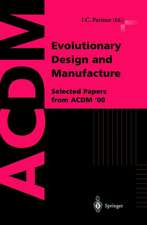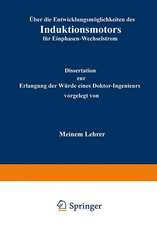Active Origami: Modeling, Design, and Applications
Autor Edwin A. Peraza Hernandez, Darren J. Hartl, Dimitris C. Lagoudasen Limba Engleză Hardback – 23 iul 2018
| Toate formatele și edițiile | Preț | Express |
|---|---|---|
| Paperback (1) | 1225.79 lei 6-8 săpt. | |
| Springer International Publishing – 12 ian 2019 | 1225.79 lei 6-8 săpt. | |
| Hardback (1) | 1232.09 lei 6-8 săpt. | |
| Springer International Publishing – 23 iul 2018 | 1232.09 lei 6-8 săpt. |
Preț: 1232.09 lei
Preț vechi: 1502.55 lei
-18% Nou
Puncte Express: 1848
Preț estimativ în valută:
235.82€ • 245.26$ • 197.62£
235.82€ • 245.26$ • 197.62£
Carte tipărită la comandă
Livrare economică 13-27 martie
Preluare comenzi: 021 569.72.76
Specificații
ISBN-13: 9783319918655
ISBN-10: 3319918656
Pagini: 512
Ilustrații: XXI, 464 p. 263 illus., 38 illus. in color.
Dimensiuni: 155 x 235 mm
Greutate: 0.86 kg
Ediția:1st ed. 2019
Editura: Springer International Publishing
Colecția Springer
Locul publicării:Cham, Switzerland
ISBN-10: 3319918656
Pagini: 512
Ilustrații: XXI, 464 p. 263 illus., 38 illus. in color.
Dimensiuni: 155 x 235 mm
Greutate: 0.86 kg
Ediția:1st ed. 2019
Editura: Springer International Publishing
Colecția Springer
Locul publicării:Cham, Switzerland
Cuprins
Chapter 1.Introduction to Active Origami Structures.- Chapter 2. Kinematics of Origami Structures with Creased Folds.- Chapter 3. Unfolding Polyhedra Method for the Design of Origami Structures with Creased Folds.- Chapter 4.Tuck-Folding Method for the Design of Origami Structures with Creased Folds.- Chapter 5.Kinematics of Origami Structures with Smooth Folds.- Chapter 6.Unfolding Polyhedra Method for the Design of Origami Structures with Smooth Folds.- Chapter 7.Tuck-Folding Method for the Design of Origami Structures withSmooth Folds.- Chapter 8.Structural Mechanics and Design of Active Origami Structures.
Notă biografică
Edwin A. Peraza Hernandez is a postdoctoral researcher in the Department of Aerospace Engineering at Texas A&M University. He obtained his B.S. and Ph.D. degrees in Aerospace Engineering from Texas A&M University in 2012 and 2016, respectively. His research interests include structural mechanics, design optimization, active materials, origami, and tensegrity. Edwin is the author of more than 28 technical publications in archival journals and conference proceedings and has received two best paper awards.
Darren J. Hartl received his BS in Aerospace Engineering in 2004 and Ph.D. in Aerospace Engineering in 2009, both from Texas A&M University. He currently holds an Assistant Professor position at Texas A&M in his home department, and his work bridges the topics of advanced multifunctional material systems and their integration into aerospace platforms. After over three years as a Research Assistant Professor at Texas A&M, Dr. Hartl held jointappointments at the Air Force Research Laboratory (AFRL) in the Materials and Manufacturing Directorate and Aerospace Systems Directorate. At Texas A&M, Dr. Hartl maintains an active research team consisting of graduate, undergraduate, and postdoctoral researchers. He has over 16 years of experience working with shape memory alloys and morphing structures and his efforts have included both experimental and theoretical studies. Since 2006, Darren has co-authored 146 technical publications on the topics of active materials modeling, testing, and integration into morphing structures. He has given over 25 invited talks or seminars (9 international) and has taught short courses on SMA theories in the US and Europe. Since 2014, he has served as an Associate Editor for the Journal of Intelligent Material Systems and Structures. He was recently selected as the 2016 recipient of the ASME Gary Anderson Early Achievement Award.
Dimitris C. Lagoudas is currently the Associate Vice Chancellor for Engineering Research, Senior Associate Dean for Research, Deputy Director of Texas A&M Engineering Experiment Station (TEES), the inaugural recipient of the John and Bea Slattery Chair in Aerospace Engineering, and a Distinguished University Professor at Texas A&M University. D.C. Lagoudas’ research involves the design, characterization, and modeling of multifunctional material systems at nano, micro, and macro levels with averaging micromechanics methods developed to bridge the various length scales and functionalities including mechanical, thermal, and electrical properties of nanocomposites. His research team is one of the most recognized internationally in the area of modeling and characterization of shape memory alloys. He has co-authored more than 450 scientific publications in archival journals and conference proceedings. He has published extensively on the subject of shape memory alloys with his students, postdoctoral associates and colleagues and several of his journal papers are now considered classic papers in the field. The theoretical models that his research group developed have been implemented and integrated into finite element analysis software, which have been used by academic institutions around the world and also by industry and government laboratories. D.C. Lagoudas received the 2006 ASME Adaptive Structures and Material Systems Prize in recognition of his contributions to the modeling and characterization of shape memory alloys and their use in aerospace structures and he is the 2011 recipient of the SPIE Smart Structure and Materials Lifetime Achievement Award.
Darren J. Hartl received his BS in Aerospace Engineering in 2004 and Ph.D. in Aerospace Engineering in 2009, both from Texas A&M University. He currently holds an Assistant Professor position at Texas A&M in his home department, and his work bridges the topics of advanced multifunctional material systems and their integration into aerospace platforms. After over three years as a Research Assistant Professor at Texas A&M, Dr. Hartl held jointappointments at the Air Force Research Laboratory (AFRL) in the Materials and Manufacturing Directorate and Aerospace Systems Directorate. At Texas A&M, Dr. Hartl maintains an active research team consisting of graduate, undergraduate, and postdoctoral researchers. He has over 16 years of experience working with shape memory alloys and morphing structures and his efforts have included both experimental and theoretical studies. Since 2006, Darren has co-authored 146 technical publications on the topics of active materials modeling, testing, and integration into morphing structures. He has given over 25 invited talks or seminars (9 international) and has taught short courses on SMA theories in the US and Europe. Since 2014, he has served as an Associate Editor for the Journal of Intelligent Material Systems and Structures. He was recently selected as the 2016 recipient of the ASME Gary Anderson Early Achievement Award.
Dimitris C. Lagoudas is currently the Associate Vice Chancellor for Engineering Research, Senior Associate Dean for Research, Deputy Director of Texas A&M Engineering Experiment Station (TEES), the inaugural recipient of the John and Bea Slattery Chair in Aerospace Engineering, and a Distinguished University Professor at Texas A&M University. D.C. Lagoudas’ research involves the design, characterization, and modeling of multifunctional material systems at nano, micro, and macro levels with averaging micromechanics methods developed to bridge the various length scales and functionalities including mechanical, thermal, and electrical properties of nanocomposites. His research team is one of the most recognized internationally in the area of modeling and characterization of shape memory alloys. He has co-authored more than 450 scientific publications in archival journals and conference proceedings. He has published extensively on the subject of shape memory alloys with his students, postdoctoral associates and colleagues and several of his journal papers are now considered classic papers in the field. The theoretical models that his research group developed have been implemented and integrated into finite element analysis software, which have been used by academic institutions around the world and also by industry and government laboratories. D.C. Lagoudas received the 2006 ASME Adaptive Structures and Material Systems Prize in recognition of his contributions to the modeling and characterization of shape memory alloys and their use in aerospace structures and he is the 2011 recipient of the SPIE Smart Structure and Materials Lifetime Achievement Award.
Textul de pe ultima copertă
Origami structures have the ability to be easily fabricated from planar forms, enable the deployment of large structures from small volumes, and are potentially reconfigurable. These characteristics have led to an increased interest in theoretical and computational origami among engineers from across the world. In this book, the principles of origami, active materials, and solid mechanics are combined to present a full theory for origami structures. The focus is on origami structures morphed via active material actuation and formed from sheets of finite thickness. The detailed theoretical derivations and examples make this an ideal book for engineers and advanced students who aim to use origami principles to develop new applications in their field.
Caracteristici
A comprehensive review of state of the art origami with active materials is provided; The kinematics, design, and structural mechanics of origami with conventional creased folds and with active smooth folds are developed in a systematic way via unified notation and formulation; Several implementation examples and problems are provided in each chapter to increase understanding of the developed theories and challenge further thought; Codes for the implementation of all presented theories are provided in the supplemental material.




























